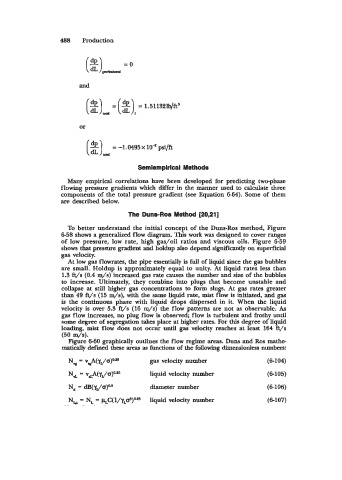Page 533 - Standard Handbook Petroleum Natural Gas Engineering VOLUME2
P. 533
488 Production
and
(%)& = 1.51132Wft'
or
(%) = -1.0495~10~psi/ft
told
Semiemplrlcal Methods
Many empirical correlations have been developed for predicting two-phase
flowing pressure gradients which differ in the manner used to calculate three
components of the total pressure gradient (see Equation 6-64). Some of them
are described below.
The Duns-Ros Method [20,21]
To better understand the initial concept of the Duns-Ros method, Figure
6-58 shows a generalized flow diagram. This work was designed to cover ranges
of low pressure, low rate, high gas/oil ratios and viscous oils. Figure 6-59
shows that pressure gradient and holdup also depend significantlr on superficial
gas velocity.
At low gas flowrates, the pipe essentially is full of liquid since the gas bubbles
are small. Holdup is approximately equal to unity. At liquid rates less than
1.3 ft/s (0.4 4s) increased gas rate causes the number and size of the bubbles
to increase. Ultimately, they combine into plugs that become unstable and
collapse at still higher gas concentrations to form slugs. At gas rates greater
than 49 ft/s (15 m/s), with the same liquid rate, mist flow is initiated, and gas
is the continuous phase with liquid drops dispersed in it. When the liquid
velocity is over 5.3 ft/s (16 m/s) the flow patterns are not as observable. As
gas flow increases, no plug flaw is observed; flow is turbulent and frothy until
some degree of segregation takes place at higher rates. For this degree of liquid
loading, mist flow does not occur until gas velocity reaches at least 164 ft/s
(50 WS).
Figure 6-60 graphically outlines the flow regime areas. Duns and Ros mathe
matically defied these areas as functions of the following dimensionless numbers:
N, = v,A(*IJa)OS gas velocity number (6-104)
NvL = V,A(YJQ)~." liquid velocity number (6105)
Nd = dB(~Jf3)~~ diameter number (6-106)
N, = N, = ~C(l/yL&)os liquid velocity number (6-107)

